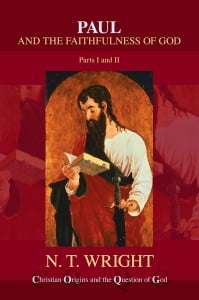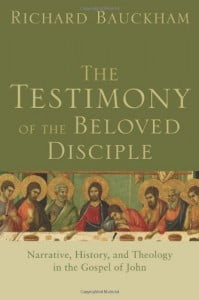Secret Codes in the Bible…and N T Wright
 To my dear reader: I wonder if I could tempt you to reach for your re-create ofPaul and the Faithfulness of God by Tom Wright. (Don't worry—but let that door close.) Turn with me, if you will, to folio 1032, department (j) entitled 'What then nearly Torah?'. Make a note of the get-go letter of the commencement discussion of each paragraph through to the end of the section on page 1037. Do y'all detect annihilation? Does it make sense to you? And here's the interesting question: would you have noticed this if I hadn't pointed it out to y'all?
To my dear reader: I wonder if I could tempt you to reach for your re-create ofPaul and the Faithfulness of God by Tom Wright. (Don't worry—but let that door close.) Turn with me, if you will, to folio 1032, department (j) entitled 'What then nearly Torah?'. Make a note of the get-go letter of the commencement discussion of each paragraph through to the end of the section on page 1037. Do y'all detect annihilation? Does it make sense to you? And here's the interesting question: would you have noticed this if I hadn't pointed it out to y'all?
On this, I recently received an email which might make sense of what you have found:
Tom preached at my father'southward funeral a year ago, and was revising this particular department when I rang to tell him. It's rather beautiful every bit a way of remembering, the more so for being subconscious.
My guess is that this is not the get-go, nor but, 'hidden' characteristic of Tom's books. I call up information technology has been fairly widely noted that the two volumes of PatFoG comprise xvi chapters, of which capacity nine to 11 are, by Tom's admission, are the middle of the argument. Does that remind you of anything?! And Tom has been at it before. I am reliably informed that there is a similar acrostic reference to his godmother from p 125 ofJesus and the Victory of God. I suspect there are many other things hidden away, and that somebody volition have fun tracking them all downward.
 We might so enquire: if Tom Wright tin hibernate things in his text, could the biblical authors not do the same? The idea of 'hidden codes' in the Bible got a bad press a few years ago with the publication ofThe Bible Code. Michael Drosnin argues that you tin can rearrange the letters of the Hebrew text of the Bible, and by figurer search, discover all sorts of 'predictions' of world events in history. This was completely unconvincing for several reasons. First, since Hebrew has (in the strict sense) no vowels, you could find almost annihilation you liked. Secondly, it was therefore clear that this was not something in the text itself, but in Drosnin's mind. If I rearrange the letters of anything I am reading, I can find whatever I am seeking. And then what? The third, more than pregnant point, is that this was not part of the intention of the author in writing, and would not take been understood by readers—so is not, in fact, part of the communicative function of the text.
We might so enquire: if Tom Wright tin hibernate things in his text, could the biblical authors not do the same? The idea of 'hidden codes' in the Bible got a bad press a few years ago with the publication ofThe Bible Code. Michael Drosnin argues that you tin can rearrange the letters of the Hebrew text of the Bible, and by figurer search, discover all sorts of 'predictions' of world events in history. This was completely unconvincing for several reasons. First, since Hebrew has (in the strict sense) no vowels, you could find almost annihilation you liked. Secondly, it was therefore clear that this was not something in the text itself, but in Drosnin's mind. If I rearrange the letters of anything I am reading, I can find whatever I am seeking. And then what? The third, more than pregnant point, is that this was not part of the intention of the author in writing, and would not take been understood by readers—so is not, in fact, part of the communicative function of the text.
Recognising these issues is not a reason for writing the idea off altogether. In an excellent gear up of studies on Matthew from the Tyndale Study Group,Built Upon a Rock, Stephanie Black notes that language is not very efficient in communicating. Alongside the data conveyed past language is a whole lot of other stuff which is not strictly necessary. This of class explains why we manage to communicate in the abbreviated class of things like text messages and Twitter. This boosted, unnecessary stuff gives language its style, its personality and its dash—which is why abbreviated communication can sometimes be misleading! She then looks at how Matthew uses this 'surplus' in his distinctive mode—but information technology could exist use to hide codes of diverse sorts, and in detail, numerology.
It is reasonably well-established that the Book of Revelation uses numerology fairly extensively. I am quite surprised when some even contempo commentators remark on Rev xiii.xviii 'We should not treat this as a lawmaking.' It really does look as though the writer intended us to! In fact, Revelation uses numerology in three distinct ways:
- Gematria (the Hebrew term) or isopsephism (the Greek term), where the numerical value of messages and words has significance, usually past identifying two words or phrases that have equal value.
- The mathematical feature of numbers as foursquare (144), triangular (666) or rectangular (42).
- Word frequencies, where significant terms occur a certain number of times throughout the work.
 Go to chapter 11 of Richard Bauckham's The Climax of Prophecy or the summary and my own comment in my Grove bookletHow to Read the Book of Revelationto discover out more.Richard has also washed extensive work looking at the numerical literary features of John'south gospel, particularly in relation to the significance of the 153 fish in John 21, which he published every bit the terminal chapter in his collection of essaysThe Testimony of the Beloved Disciple. Hither, he notes that much work has been washed on numerical literary features, but it has often been by-passed and its significance ignored. He highlights some remarkable features of John's gospel:
Go to chapter 11 of Richard Bauckham's The Climax of Prophecy or the summary and my own comment in my Grove bookletHow to Read the Book of Revelationto discover out more.Richard has also washed extensive work looking at the numerical literary features of John'south gospel, particularly in relation to the significance of the 153 fish in John 21, which he published every bit the terminal chapter in his collection of essaysThe Testimony of the Beloved Disciple. Hither, he notes that much work has been washed on numerical literary features, but it has often been by-passed and its significance ignored. He highlights some remarkable features of John's gospel:
- The prologue (John 1.ane–18) consists of 496 syllables. 496 is both a triangular number and a perfect number—and it is the numerical value of the Greek termmonogenes ('just') in John i.14 and John 1.18.
- The next section, from John one.19 to John ii.11, consists of 1550 syllables, which is the value of the phraseho Christos, ('The Christ').
- Jesus 'high priestly prayer' to the Begetter in John 17.1b–26 consists of 486 words, and 486 is the numerical value ofpater ('father').
Having noted these, Bauckham adds a fourth of his own:
- The numerical value of 'Jesus' in Hebrew is the same as the numerical value of 'Lamb of God' in Hebrew, 391. Then when John the Baptist proclaims 'Behold, the Lamb of God!' in John i.29 and John i.35–36, he is doing gematria with Jesus' name.
These are unusual ways of reading the text; if you lot warm to these observations it probably says something about yous! Many only find them baffling—but the central question is: could John have done this in his writing? At each stage, Bauckham is careful to note that only sure terms announced to have numerical significance, and he also supports this approach by observing its historical plausibility:
It may be that some aspects of numerical composition were non expected to be directly discerned by readers, but were idea to give appropriate course to the text, as ways of conforming the lengths and proportions of the text to its meaning. But we should remember that counting the number of syllables or words in a text was not equally unfamiliar an activity then as information technology is now: it was regularly washed to determine the price of manuscripts and for scribes to check the accuracy of their transcriptions.
And he points out that not seeing these patterns does non detract from the meaning of the text for ordinary readers. Unlike the DrosninBible Code arroyo, these hidden patterns back up the more obvious sense of the text rather than contradicting it or saying something completely unrelated.
(Now Richard and I have recently had some more correspondence on this subject field. I pointed out to him a gematria I had come across, where 'the Son of Man' in Hebrew has the same value as 'serpent', both equal to 558. Richard looked further and found like gematria for four other of the 12 occurrences of 'The Son of Man'…which is why he is a Young man of the Royal Society and I am not!)
 Does this accept significance for biblical scholarship? Yes, argues Bauckham. Information technology demonstrates that, contrary to decades of scholarship, John's gospel and the Book of Revelation were not the result of successive editing processes and composition past a series of writers, only were the production of careful composition by an individual. The difficulty here is that many people already have a vested involvement in theories of limerick through their ain research—so they are going to have some persuading. But the data looks rather impressive to me.
Does this accept significance for biblical scholarship? Yes, argues Bauckham. Information technology demonstrates that, contrary to decades of scholarship, John's gospel and the Book of Revelation were not the result of successive editing processes and composition past a series of writers, only were the production of careful composition by an individual. The difficulty here is that many people already have a vested involvement in theories of limerick through their ain research—so they are going to have some persuading. But the data looks rather impressive to me.
More, than this, these kind of insights to have an impact for ordinary readers. It suggests that many texts of the New Testament were equanimous with extraordinary care—and so they should be read very advisedly in their turn. Aslope reading longer passages, perhaps the practice of concentrating on and memorising smaller portions isn't then bad after all.
Somewhen, you might even spot the secret message hidden in this weblog mail service!
Additional note:There is some other rather overnice example of an acrostic code in this US local paper leader on Kirby Delauter which went viral on Twitter for a while.
I piece of work freelance. If you accept valued this post, would y'all considerdonating £1.20 a month to support the product of this blog?
If you enjoyed this, do share information technology on social media (Facebook or Twitter) using the buttons on the left. Follow me on Twitter @psephizo. Like my folio on Facebook.
Much of my work is washed on a freelance basis. If yous take valued this mail, yous can brand a single or echo donation through PayPal:
Comments policy: Skillful comments that appoint with the content of the mail service, and share in respectful argue, tin add existent value. Seek first to empathise, and so to exist understood. Brand the nigh charitable construal of the views of others and seek to learn from their perspectives. Don't view debate as a conflict to win; address the argument rather than tackling the person.
Source: https://www.psephizo.com/biblical-studies/secret-codes-in-the-bibleand-n-t-wright/
0 Response to "Secret Codes in the Bible…and N T Wright"
ارسال یک نظر